In-season Tracking
 Yelloweye Rockfish Catch Compared to Harvest Limit.
Yelloweye Rockfish Catch Compared to Harvest Limit.
 Yelloweye rockfish. CDFW photo.
Yelloweye rockfish. CDFW photo.
One of the main goals of the California Department of Fish and Wildlife's (CDFW) Groundfish Project is to manage fish stocks sustainably, based on state or federally mandated harvest limits. Marine recreational fisheries monitoring is performed by CDFW and federal partners to ensure California's recreational catch accumulates up to, but does not exceed, the annual harvest limits. Yelloweye rockfish (Sebastes ruberrimus) is a challenging species to manage because the statewide recreational harvest limit is very restrictive - 9.1 metric tons (mt) or 20,062 pounds. This limit resulted from very low population estimates. While they may not be retained by fishermen, some yelloweye rockfish are caught because they co-occur with other rockfishes that are targeted by fishermen, and some of the yelloweye rockfish that are caught will die when released. The harvest limit is the amount of "bycatch mortality" allowed off California while fishing for other target species. Yelloweye rockfish is the most constraining species on the West Coast and given the highest priority for tracking catches. Yelloweye rockfish is a federally-designated "overfished species" and is slow growing, late maturing, and can reach an age of over 100 years.
The California Recreational Fisheries Survey (CRFS) supplies monthly catch estimates by area. Producing CRFS estimates requires information on catches and effort from several sources. As a result, there is a five- to eight-week lag time between when the catch data are collected and when catch estimates using angler effort are generated. During the intervening weeks, CDFW performs special tracking for yelloweye rockfish using preliminary CRFS weekly field reports. These preliminary reports are converted into an anticipated catch value (ACV) in mt using catch and effort data from previous years. This weekly "proxy" value is used to approximate catch during the lag time, until the corresponding monthly CRFS estimates are available. In the "thermometer" to the left, yellow represents ACVs and grey stipple represents CRFS estimates. This combined total (ACV+CRFS estimates) represents CDFW's best estimate of yelloweye rockfish catches to date. CDFW maintains a conservative buffer around the best estimate to account for unpredictable variability in the catches due to weather, fuel prices, possible error in the projections, and other unforeseen factors.
Every effort is made to provide as much fishing opportunity as possible without exceeding the harvest limit. Recreational anglers can help in this effort by accurately reporting their catch, both landed and released, to CRFS samplers every time they are approached for an interview. Under-reporting of catch will prevent stock assessment scientists from determining if populations have recovered. Over-reporting may result in unnecessary action to close the fishery. If you are approached by a CRFS sampler for an interview, please report exactly what you caught to the best of your ability and ask the CRFS sampler to show you an identification guide if you are unsure.